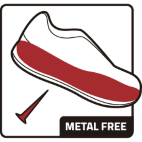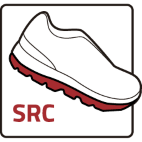Certificates and iconography
The development of safety footwear and protection is a priority for us. Therefore, our footwear meets the requirements of our customers and we certify all our products according to the European regulation. EU 2016/425.
Iconography
Levels of protection

This level includes the same characteristics as the SB category and adds the following:
FO: Hydrocarbon resistant sole
 You will find this icon on our website as an indicator of this feature.
You will find this icon on our website as an indicator of this feature.A: antistatic footwear whose resistance is above 100 kΩ and is not higher than 1000 MΩ
 You will find this icon on our website as an indicator of this feature.
You will find this icon on our website as an indicator of this feature. E: energy absorption in the heel area
 You will find this icon on our website as an indicator of this feature.
You will find this icon on our website as an indicator of this feature.
It is the combination of category S1 with a fixed anti-puncture insole.
 You will find this icon on our website as an indicator of this feature.
You will find this icon on our website as an indicator of this feature.
This is the combination of category S1 with the addition of water penetration and absorption resistance called

This is the highest category of footwear protection, combining the S2 category with the addition of a fixed, puncture-resistant insole (called
 You will find this icon on our website as an indicator of this feature.
You will find this icon on our website as an indicator of this feature.
The toe cap is resistant to an energy impact equivalent to 200 J (200 Joules), i.e. to the fall of a 20 kg object from a height of 1 metre, and to a compression of 15 kN (15 kilo Newtons), which translates into 1.5 tonnes.
 You will find this icon on our website as an indicator of this feature.
You will find this icon on our website as an indicator of this feature.In addition, it must be slip resistant; there are several levels of resistance:
- SRA: tested on ceramic floor with detergent
- SRB: tested on steel floor with glycerine
- SRC: is the combination of both tests (SRA + SRB).
Our footwear is certified in the latter category, thus obtaining the highest degree of slip resistance.
 You will find this icon on our website as an indicator of this feature.
You will find this icon on our website as an indicator of this feature.
Electrostatic protection
The ESD footwear developed by V-PRO has been designed according to the requirements of the EN 61340 standard dealing with the manufacture of electrostatic discharge sensitive electronic articles.
ESD footwear is one in which the requirement for static charge dissipation is higher, as even the slightest charge on the wearer can affect the performance of their work (clean rooms, work with printed circuit boards, precision painters avoiding dust motes...).
The sole contains higher doses of the antistatic component in its composition, and the insole contains a higher quantity of conductive thread.
This footwear is conductive of the smallest electrostatic charges accumulated by the worker. The function of this type of footwear is to divert these charges to the outside.
Uses
Other icons
EC Certificates
EN ISO 20344
This standard defines the test methods for safety and work shoes. It is used in conjunction with
EN ISO 20345
Specification for safety footwear marked with the letter "S".
This international standard specifies basic and additional requirements for safety footwear, including mechanical hazards: safety toe cap designed to withstand a maximum impact of 200 J and crushing of up to 15 kN, slip resistance, thermal hazards and ergonomic performance.
EN ISO 20347
Specification for occupational footwear marked with the letter "O".
This international standard specifies the basic and additional requirements for occupational footwear that is not exposed to any mechanical risk (impact or compression)*.
* Taken from UNE EN ISO 20347:2013 Personal protective equipment. Work footwear. Purpose and field of application





